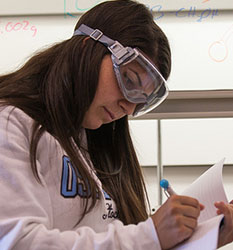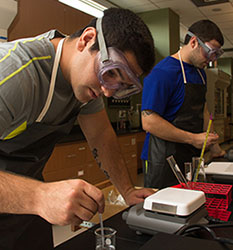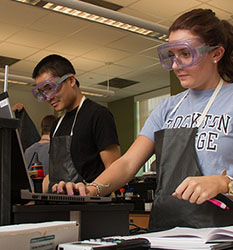Chemistry Research
Research experience is an essential part of the Chemistry curriculum at Stockton. Faculty work with students on a variety of student-focused projects related to their current research interests. Students are encouraged to get involved in research as early as their schedule allows. Students interested in research should explore the areas listed below and contact Chemistry faculty members directly.
Senior projects
All Chemistry majors complete a senior project that is performed in conjunction with a faculty mentor on campus or through an off-campus internship. For students working on campus, projects typically span multiple semesters in order to give them an opportunity to develop their research skills and produce significant results. All graduating seniors present their work to the Stockton community at the Senior Research Symposium at the end of each semester.



Current Research Interests
Continuous flow synthesis and structure-property relationships of heterocycles
Dr. Erin Brown
Associate Professor of Chemistry
My research is based in synthetic organic chemistry and continuous flow technology. Our lab concentrates on synthesizing heterocyclic compounds, studying their properties (e.g. optical), and using continuous flow to improve reaction efficiency. Currently, our efforts focus on synthesizing and studying the structure-property relationships of several carbazole derivatives and also utilizing continuous flow technology to synthesize various heterocycles in a single step from simple phenol precursors. Students can expect to be involved in all aspects of the research and have opportunities to learn synthetic chemistry skills, such as running reactions under inert atmosphere or in a continuous flow reactor, performing product purification via flash-column chromatography, and characterizing compounds.
Liquid crystalline materials with a complex stimuli response
Dr. Pamela Cohn
Associate Professor of Chemistry
My projects broadly fall under the category of physical organic chemistry, wherein principles underlying an organic molecule’s structure and reactivity are studied in a bulk material. These structure-property relationships allow for a deeper understanding of how a structural feature of a molecule gives rise to its observed properties. Natural systems apply this “bottom up” approach to build large stimuli-responsive assemblies from individual molecules by incorporating information-rich structural units (e.g. hydrogen bonding and aromatic stacking motifs). I seek to expand on this approach by incorporating principles of bottom-up assembly to create new classes of “smart” materials (materials that can perform a specific task in response to an external stimulus). Students will learn state of the art organic synthetic techniques in order to generate libraries of structural analogs of a particular molecule. Then these analogs can be characterized at the molecular and macroscopic levels in order to establish how changes to molecular structure affect a material's observable properties.
Coastal biogeochemistry: Understanding the coastal carbon cycle
Dr. Sarah Gray
Assistant Professor of Chemistry
My research is in the area of analytical chemistry, which involves identifying and quantifying different substances. One main application my lab focuses on is understanding how changing climate conditions are affecting coastal aquatic ecosystems. Through the development and use of field sensors to measure carbon parameters in natural waters we hope to extend our knowledge of the variability of inorganic carbon in coastal environments and to identify the factors that are driving these changes. This work combines aspects of both field and laboratory work. Students can expect to learn about equilibrium processes in aquatic ecosystems, how to carry out analytical procedures with a high degree of accuracy and precision, and how to operate laboratory and field instrumentation.
Analysis of terpenes in Atlantic White Cedar
Dr. Kristen Hallock-Waters
Associate Professor of Chemistry
My current research focuses on the development of a chemical forest ecology for Atlantic White Cedar (Chamaecyparis thyoides). The Atlantic White Cedar population along the U.S. east coast has declined in recent decades due to logging, land use changes, and alterations in stream flow. Despite conservation efforts, this species has failed to regenerate largely due to herbivory. As part of a collaboration with Environmental Science faculty, we are using gas chromatography-mass spectrometry to characterize needle terpenes in Atlantic White Cedar populations exposed to minimal and heavy deer browsing and determining if the stress induced by herbivory induces changes in the types and quantities of secondary metabolites produced. We are also using ion chromatography to investigate variation in nutrient uptake.
Development of inexpensive iron and nickel catalysts for transfer hydrogenation
Dr. Steve Kalman
Associate Professor of Chemistry
The research in my laboratory is in the area of organometallic chemistry. Our efforts are directed toward synthesizing inorganic compounds based on inexpensive first-row transition metals and using these new compounds as catalysts for organic reactions. We hope that the new catalysts will improve the efficiency of the reactions, decrease energy input, and decrease the quantity of waste. Students will have the opportunity to learn how to perform reactions under an inert atmosphere and study reaction mechanisms. Current projects in my lab are focused on the applications of bifunctional N-heterocyclic carbene ligands in iron and nickel catalyzed transfer hydrogenation reactions. Other projects revolve around the development of new experiments for the inorganic chemistry laboratory.
Protein characterization of the vacuole
Dr. Kelly Keenan
Associate Professor of Chemistry
My research interests focus on characterizing proteins found within the vacuole, an organelle found in plants and fungus including Neurospora crassa. The function of the vacuole in fungus is not defined completely but it does transport a number of molecules in and out; this process requires transport proteins. Similar proteins are used to transport neurotransmitters and are the targets for a number of drugs including anti-depressants. Such proteins have proven to be difficult to characterize and knockout mutants have been employed to study these proteins.
Development of solution-processed semiconductor thin films for energy applications
Dr. Wooseok Ki
Assistant Professor of Chemistry
My research focuses on studying the structure and properties of emerging earth abundant semiconductor materials for energy related applications, such as phosphors for solid state lighting, electrodes for water splitting, and absorbers for thin film solar cells. We are also interested in developing multifunctional porous inorganic materials by using molecular precursor routes to control electron and mass transport, electronic and ionic conduction, electron-transfer kinetics to enhance device performance. Students will have an opportunity to learn the design, synthesis, and characterization of new semiconductor materials to understand their structural, physical, and chemical properties.
Investigating the structure and function of proteins
Dr. Jennifer Martin
Assistant Professor of Chemistry
My research interests are two-fold: 1) investigating the relationship between protein structure and function, and 2) working towards understanding membrane protein folding. More specifically, I am to experimentally investigate the function of enzymes with previously determined structures. For this research aim, we utilize computational tools and databases to look at sequence and structure homology to proteins that have been previously characterized functionally. Additionally, we will develop functional assays to be conducted in the lab to determine the efficiency and substrate specificity of these enzymes. Once we develop a working functional assay, we can further investigate the enzyme’s function by varying conditions (temperature, pH, etc.), and investigating inhibitors. For research aim 2, I am interested in investigating factors that affect membrane protein folding in vitro. Despite their abundance and importance, membrane proteins remain far less characterized than soluble proteins. A major difficulty in studying membrane proteins is the need for a membrane mimetic that will stabilize both the fold and the function of these proteins. To this end my second research area focuses on the investigation into the optimal conditions for specific membrane proteins to fold into various membrane mimics (detergent micelles, liposomes, etc).
Computational investigation of molecular structure and reactivity
Dr. Robert Olsen
Assistant Professor of Chemistry
My research interests center on using computational tools to elucidate molecular structure and chemical reaction mechanisms. Ongoing projects include (1) using molecular modeling software to identify the reactive sites of molecules and applying information about reactivity to determine pathways from reactants through the transition state to products (in collaboration with Drs. Rajaraman and Cohn), (2) using molecular modeling software to probe the interaction of weak hydrogen bond donors and acceptors, such as chloroform and acetone, and (3) using numerical methods to investigate biochemical reaction networks by tracking substrate, enzyme, reactive intermediate and product concentrations over time (in collaboration with Dr. Pollock).
Metabolic Profiling of Stresses on Biological Organisms
Dr. Elizabeth Pollock
Associate Professor of Chemistry
The research projects I am currently engaged in involve the investigation of the impact of environmental changes, be they physical or chemical, on the biochemical processes of impacted organisms. In particular, I am interested in understanding how metabolite levels in an organism change over time and whether or not these changes can be correlated to specific biochemical pathways or indicators of reduced fitness of an organism to its environment. All of my current research falls under the broad category of environmental metabolomics, specifically using NMR-based metabolic profiling techniques to assess changes in non-model organisms of ecological significance. Examples include assessing changes in cellular components during development and the impact of parasite load in young American eels, temperature stress and adaptation in algae and the consequences of exposure to ionic liquids on seedling growth and development.
Synthesis of novel platinum-group metal complexes for luminescence studies
Dr. GorDan Reeves
Assistant Professor of Chemistry
My research focuses on the synthesis of novel platinum-group metal complexes for use as luminescent probes. Complexes of these types have been heavily studied for the last three decades with some of their earliest applications being the refinement of solar energy focusing on using the character of the metal complex to split water. Additionally, these complexes have been noted for their long excited state lifetimes, making them especially important in the development of O2 and pH sensors, electroluminescent cells, DNA binding studies and additives for photovoltaic cells and polymer systems.
Trace explosive analysis and characterization
Dr. Marc Richard
Associate Professor of Chemistry
My research focuses on studying the properties of trace explosives in an effort to improve standards development and detection. I work closely with Dr. Louise Sowers and with collaborators at government laboratories. This work involves several different types of analytical instrumentation, including gas chromatography/ECD, gas chromatography/mass spectrometry, differential scanning calorimetry, thermal gravimetric analysis, and ion mobility spectrometry. Past student projects have included method development, stability studies, and an analysis of particle collection efficiency.


